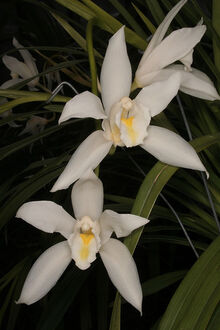| |||||||||||||||||
Cymbidium eburneum is a species of Cymbidium.
Description Edit
Edit
Plant blooms from winter to spring with one to two 12 cm wide flowers. Flowers are fragrant with the scent of lilac which is usually recessive in hybridization.
This species has a short inflorescence with a single large white flower.[1] It is distinguished from other larges cymbidium species by having callus ridges which are fused.[1]
The plant was first described by Lindley in 1847 from a species in Loddiges' nursery which was collected from the East Indies. It was later described by Griffith in 1851 as Cymbidium syringodorum, which was named after its lilac scent, and described to be from the Khasia Hill in Assam India.[1]
Reichenbach described two variation in color Cymbidium eburneum var. philbrickianum which was pure white with a yellow callus and Cymbidium eburneum var. williamsianum which was also called var. dayi by Jennings in 1875, had a yellow callus and a pink tingle patch.[1]
Distribution Edit
Edit
Plant is found growing on rocks and trees in Assam India, eastern Himalayas, Nepal, Myanmar, Yunnan China and Vietnam at elevations around 300 to 2000 meters
Culture Edit
Edit
Plant should be grown in cool areas with medium to bright light. Pot with bark and perlite. Plant prefers dry periods between watering. Reduce watering during the late fall to spring. Water about once a week.
Varieties Edit
Edit
Naming Edit
Edit
Common Name: The Ivory-Colored Cymbidium
References
1.Ref 1



No comments:
Post a Comment